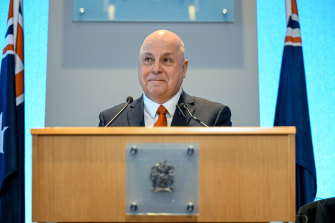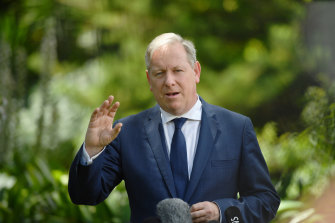Key points
- Economists are divided on what impact the faster than expected rate rises will mean for Victoria’s projected surplus of $650 million in 2025-26.
- The Reserve Bank this week delivered its biggest one-off interest rate rise in more than two decades.
- The state government says the impact of interest rate movements is smoothed by spreading largely fixed-rate borrowings evenly over a 15-year period.
The Reserve Bank’s decision to raise interest rates more quickly than anticipated has heaped further pressure on Victoria’s finely balanced budget and cast doubt over the Andrews government’s claims the state will be back in surplus within four years.
On Tuesday the RBA delivered its biggest one-off interest rate rise in more than two decades, with the official cash rate now 0.85 per cent. The rate has jumped 0.75 percentage points since state Treasurer Tim Pallas handed down his budget on May 3.
Tim Pallas has forecast a surplus of $650 million by 2025-26.Credit:Joe Armao
Economists are divided on what impact the faster than expected rate rises will mean for Pallas’ projected surplus of $650 million in 2025-26, with one arguing the effect will be minimal while another says the RBA’s moves will have a deeper impact because rates are rising faster than the market anticipated and the government’s budget forecasts were based on optimistic assumptions.
“Interest rates are set to rise faster than many expected even a couple of months ago,” said Brendan Coates, an economist at the Grattan Institute.
“The futures markets now expect the cash rate to hit 4 per cent by the end of next year – that’s substantially higher than what was expected even a few weeks ago when the budget was tabled in Parliament.”
Treasury did not stipulate what it expected the interest rate figure to be over its forward estimates but noted the economic forecasts were based on rates that “broadly follow market economists’ expectations”, which would have factored in rate rises. But it conceded the RBA could lift interest rates faster than initially assumed.
It also factored in a “sensitivity analysis rate” of 1 percentage point, which showed if rates rose 1 percentage point higher than the budget had factored in, Victoria’s deficit would be $1 billion in 2025-26.
When he handed down his budget last month, Pallas said his plan to protect jobs and the economy during the pandemic had paid off and forecast a $7.9 billion deficit in 2022-23, $3.3 billion in 2023-24 and $1.1 billion in 2024-25, before a projected surplus of $650 million in 2025-26.
However, the budget largely relied on bullish economic forecasts to claim Victoria will return to surplus, including average inflation of 3 per cent this financial year, falling to 2.5 per cent the following year. Inflation is now expected to hit 6 per cent by the end of the year.
The government also banked on a $6.4 billion increase in the stamp tax haul, but the property market has slowed considerably because of rising interest rates. Premier Daniel Andrews and Pallas have previously said “austerity is not a solution” and vowed to grow their way out of debt.
Shadow treasurer David Davis expressed concern about the efffect of the interest rate rise on the Victorian budget.Credit:Joe Armao
Shadow treasurer David Davis claimed – based on the state government’s own sensitivity analysis – a 0.75-percentage-point rate rise since May 3 would lead to a $750 million impact on the budget bottom line and wipe out the government’s surplus.
“Victoria’s cannot afford more of Labor’s waste, mismanagement and budget blowouts,” Davis said.
“Daniel Andrews is addicted to debt and covering up mistakes using other people’s money. Labor wastes, you pay. Instead of throwing away money to pay for Labor’s debt, the Liberals and Nationals will end the waste and put money into fixing the health crisis.”
A government spokesman said on Wednesday that projected rate rises were factored in to Treasury forecasts and the impact of interest rate movements was smoothed by spreading largely fixed-rate borrowings evenly over a 15-year period.
“Interest rate rises have no impact on the substantial proportion of bonds that are already locked in at fixed rates for extended periods,” the spokesman said.
Coates said it was impossible to say whether the government’s predicted surplus would be wiped out – but it could be whittled away.
“It’s fair to say the faster than expected rate rises will cut into that surplus as the state borrowing costs rise faster than what we expected a few months ago. And the state government’s forecasts seemed far more optimistic than even the federal government’s.”
Ernst & Young Australia chief economist Cherelle Murphy said the Victorian government had factored rate rises into its forecasts, meaning the recent increases would have minimal impact, but she warned there was a “good argument” the state’s current spending would only add upward pressure to inflation and interest rates.
“The government makes assumptions about interest rates in the budget to help it forecast. It starts with interest rates as determined by the market, that is, the yield curve. At the moment, the yield curve says interest rates are going up,” she said.
“The sensitivity analysis in the budget tells us what would happen to government forecasts only if rates move over and above what the yield curve is saying.”
The RBA’s move on Tuesday was the biggest one-month increase in the official cash rate since February 2000, at the peak of the dot.com boom and when the property market was soaring. It is only the second rise since November 2010 after the bank last month lifted the cash rate from a record low 0.1 per cent to 0.35 per cent.
Economists were surprised by the size of the move, predicting a 0.25- or 0.4-point increase.
With Rachel Clun
The Morning Edition newsletter is our guide to the day’s most important and interesting stories, analysis and insights. Sign up here.
Most Viewed in Politics
From our partners
Source: Read Full Article


